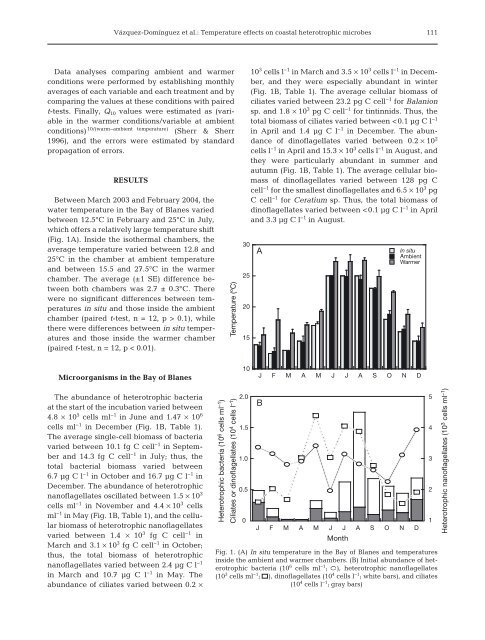Temperature effects on the heterotrophic bacteria, heterotrophic ...
Temperature effects on the heterotrophic bacteria, heterotrophic ...
Temperature effects on the heterotrophic bacteria, heterotrophic ...
Create successful ePaper yourself
Turn your PDF publications into a flip-book with our unique Google optimized e-Paper software.
Vázquez-Domínguez et al.: <str<strong>on</strong>g>Temperature</str<strong>on</strong>g> <str<strong>on</strong>g>effects</str<strong>on</strong>g> <strong>on</strong> coastal <strong>heterotrophic</strong> microbes<br />
111<br />
Data analyses comparing ambient and warmer<br />
c<strong>on</strong>diti<strong>on</strong>s were performed by establishing m<strong>on</strong>thly<br />
averages of each variable and each treatment and by<br />
comparing <strong>the</strong> values at <strong>the</strong>se c<strong>on</strong>diti<strong>on</strong>s with paired<br />
t-tests. Finally, Q 10 values were estimated as (variable<br />
in <strong>the</strong> warmer c<strong>on</strong>diti<strong>on</strong>s/variable at ambient<br />
10/(warm−ambient temperature)<br />
c<strong>on</strong>diti<strong>on</strong>s) (Sherr & Sherr<br />
1996), and <strong>the</strong> errors were estimated by standard<br />
propagati<strong>on</strong> of errors.<br />
RESULTS<br />
Between March 2003 and February 2004, <strong>the</strong><br />
water temperature in <strong>the</strong> Bay of Blanes varied<br />
between 12.5°C in February and 25°C in July,<br />
which offers a relatively large temperature shift<br />
(Fig. 1A). Inside <strong>the</strong> iso<strong>the</strong>rmal chambers, <strong>the</strong><br />
average temperature varied between 12.8 and<br />
25°C in <strong>the</strong> chamber at ambient temperature<br />
and be tween 15.5 and 27.5°C in <strong>the</strong> warmer<br />
chamber. The average (±1 SE) difference be -<br />
tween both chambers was 2.7 ± 0.3°C. There<br />
were no significant differences between temperatures<br />
in situ and those inside <strong>the</strong> ambient<br />
chamber (paired t-test, n = 12, p > 0.1), while<br />
<strong>the</strong>re were differences between in situ temperatures<br />
and those inside <strong>the</strong> warmer chamber<br />
(paired t-test, n = 12, p < 0.01).<br />
<str<strong>on</strong>g>Temperature</str<strong>on</strong>g> (ºC)<br />
30<br />
25<br />
20<br />
15<br />
10 3 cells l −1 in March and 3.5 × 10 3 cells l −1 in December,<br />
and <strong>the</strong>y were especially abundant in winter<br />
(Fig. 1B, Table 1). The average cellular biomass of<br />
ciliates varied be tween 23.2 pg C cell −1 for Balani<strong>on</strong><br />
sp. and 1.8 × 10 3 pg C cell −1 for tintinnids. Thus, <strong>the</strong><br />
total biomass of ciliates varied between
















